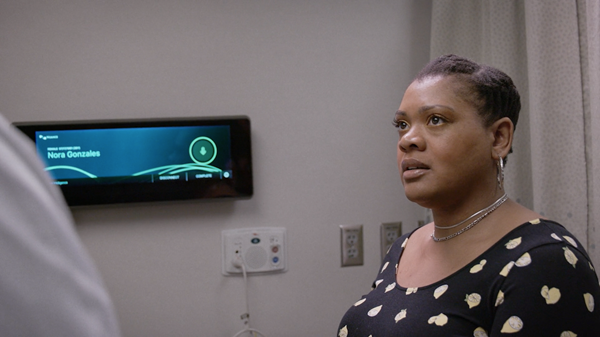As commercially available smart speakers and voice assistants have become more common in our homes and offices, people have grown accustomed to speaking to technology to record a thought or perform a simple task—check the weather, turn on the TV, or make a call. In a clinical setting, it may be just as easy to equip the ‘walls with ears,’ but to truly unburden care teams from the distractions and complexities that get in the way of helping patients—the walls need to do more than just listen for voice commands.
From tech giants to small healthcare startups, the term “ambient” is increasingly being used in many solution descriptions—but merely calling something ambient, doesn’t mean it is. True ambient solutions don’t just capture or retrieve information via a simple voice command; they listen to live conversations in a secure and passive manner and automatically create something new. In the case of ambient clinical intelligence, clinical documentation is created from real-time physician-patient conversations using advanced deep learning AI technologies; it automatically creates high-quality documentation that would normally require a physician to manually complete after the encounter.
What to look for in a true ambient clinical intelligence solution
True ambient clinical intelligence solutions go far beyond traditional speech recognition and medical scribing services by securely and unobtrusively capturing multi-party conversations in a passive manner without interfering with the flow of the conversation. Clinical-relevant information is automatically converted into a structured document and delivered to physicians directly in the electronic health record (EHR). It should be backed by a robust artificial intelligence engine built specifically to handle healthcare vocabularies and capable of accurately translating colloquial speech into clinically relevant notation by medical specialty. When considering adopting an ambient clinical intelligence solution, be thorough, and ask lots of questions, including:
- Does it automatically create clinical notes from natural multi-party conversations? In a clinical setting, a true ambient solution allows for the accurate and secure capture and contextualization of information gathered from everyone present—doctor, nurse, patient, and family members all speaking naturally and conversationally. There are no instructional commands to issue, and no explicit recap required to create the clinical note. After all, who knows the patient’s situation best? To capture a patient’s real and complete story, why not make direct and deliberate use of their own words along with those of their caretakers?
- Does it allow you to speak naturally? Everyone present should be able to speak naturally in a true unrestricted conversational manner and not as if they were talking to a computer or issuing specific commands. And it should do so in an unobtrusive and passive manner.
- Does it integrate voice biometrics? The role of an ambient solution is to surround care teams with the necessary intelligence to reduce the burden associated with clinical documentation. Employing advanced technologies like voice biometrics for speaker authentication and verification streamlines workflow and promotes even greater accuracy.
- Does it support both smartphones and purpose-built ambient hardware? The role of a device to gather information in an ambient clinical intelligence solution corresponds to its capabilities—both now and in the future. Ideally, that means offering a combined approach that allows readily available standard hardware—such as a smartphone—to listen, record, and provide virtual assistant capabilities, as well as a purpose-built device to facilitate a more productive encounter experience for everyone in the room. Purpose-built ambient devices should be designed to surround the exam room with multiple microphones, advanced ambient sensing capabilities and biometrics, as well as optional machine vision to gather and verify key information. These devices should also offer an interactive display so providers can review and share relevant information that compliments what is displayed on their standard computer monitors.
- Does it generate structured notes tailored for each specialty? To deliver the intended clinical and financial outcomes, a true ambient clinical intelligence solution should produce structured documentation by specialty that adheres to client workflows and standards, like E/M CMS97 and AHDI, to enable high-quality care, accurate coding, and enhance compliance.
- Does it support integrated virtual assistant capabilities? A true ambient clinical intelligence solution should support information retrieval and prepare a set of actions to help users react to real-time requests directly within their existing workflow. It should allow clinical staff to access integrated virtual assistant capabilities through their EHR and third-party applications that automate high-value and often time consuming clinical and administrative tasks.
- Does it include access to proven real-time speech recognition dictation capabilities tightly integrated into the EHR? Combining ambient clinical intelligence with other documentation methods such as real-time speech dictation supports an even greater range of physician workflows. Be sure to confirm that a prospective ambient solution also comes standard with such proven and highly integrated capability.
Determining reality from ambition
To get the most from your investment in ambient technology, consider partnering with an experienced, trusted vendor that has consistently demonstrated AI technology leadership in the healthcare market, maintains strategic relationships with all major EHRs, and has delivered measurable outcomes for decades.
While some vendors may refer to an offering as ambient—be careful not to confuse their ambition with your needs. Don’t just settle for explanations—demand proof with a live unscripted conversational demonstration, check references, and consider the overall offering roadmap and how well it supports your long-term strategic goals. Ambient clinical intelligence can boost physician and patient satisfaction, improve documentation quality, eliminate after-hours work, and increase patient throughput for both in-person and telehealth care. With this much potential at stake, it’s worth sorting through the facts.







